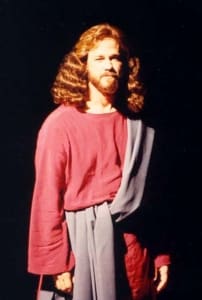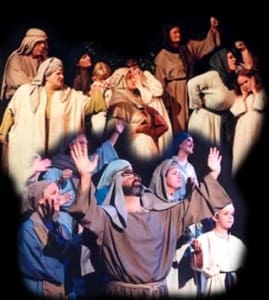.
God’s Masterpiece Cast & Costumes

.
God’s Masterpiece can be done with a cast of as few as 50 people or as many as hundreds as you celebrate the birth, death and resurrection of Jesus Christ through this simple, yet powerful Christian Easter passion play.
.
 The costumes you see in the photographs on this website were all handmade by Doris Center and her team of faithful ladies who spent thousands of hours sewing for three months. You can rent similar costumes, or set your seamstresses to work on them. Libraries have wonderful biblical costume books that can serve as templates for the basic costume designs.
The costumes you see in the photographs on this website were all handmade by Doris Center and her team of faithful ladies who spent thousands of hours sewing for three months. You can rent similar costumes, or set your seamstresses to work on them. Libraries have wonderful biblical costume books that can serve as templates for the basic costume designs.
.
You can download all of the “Cast And Costume” information included on these pages, and a “Cast List Record” sheet on which to record the names and contact information for all of the people on your cast.
![]() Download the “Cast And Costume Descriptions”
Download the “Cast And Costume Descriptions”
![]() Download The “Cast List Record”
Download The “Cast List Record”
.

Costumes
Costumes are completely up to you and the creativity of your costume-building staff; simply stay true to biblical costuming, especially when costuming the Pharisees, soldiers, the court of Pilate, and in copying the color scheme of the disciples at the “Last Supper” table. Below is a complete categorical list of the costumes for the cast of God’s Masterpiece, as well as photographs reflecting the costume choices we made when this production was staged. Again, you may copy or vary these suggestions according to your own vision.
.

Makeup
Makeup is also creatively done by your makeup artists. The best thing to do is to have your men grow their own beards several months before the production. Putting on beards is difficult, and the fewer the better! Use professional stage makeup, organize and store it in airtight bins that are labeled with cast classifications or specific character names. Ask each actor to bring a labeled ziplock bag with his/her own mascara and lipstick to guard against passing germs and illness throughout the cast.
.
The Cast
(in order of appearance)
.
.

Three Women Narrators
These are the three women who went to the tomb and found it empty. They begin the play by “remembering” their encounter with Jesus and inviting the audience to listen to their story as they sing, “I Love To Tell The Story.” They speak to the audience between the scenes of the play, providing narrative transitions that tell the story of the last week in the life of Jesus, from His triumphal entry to His resurrection and ascension.
Mary Magdalene: A faithful and forgiven follower of Jesus, who puts her own life in peril.
Costume: Green tunic and tan-colored head dress w/sash descending down over the shoulders.
Salome: A courageous follower of Jesus.
Costume: Deep blue tunic and cream-colored head dress.
Rebecca: An outspoken follower of Jesus.
Costume: Pale blue tunic and deep blue head-dress.
.

The Man With The Water Jug
A non-speaking part. This man escorts Peter and John to the upper room, where the “Last Supper” is to be held.
Costume: Standard biblical attire with head covering
.
.

Jesus
A profoundly compassionate, yet authoritative, man who is an excellent “oral interpreter” of scripture and can give biblical text the human inflection and spontaneity of actual conversation.
Costumes:
During the “prologue”:
Red tunic with blue sash, white resurrection robe
At the “Last Supper” table & “Disciple Narratives”:
Red tunic with blue sash
At the “flogging”:
Red tunic, folded at waist to reveal flesh
At the “Crucifixion”:
Swim trunks covered by cloth to look wrapped
At the “Resurrection”:
White, satin tunic with long white sash
At the “Ascension”:
Resurrection robe is worn under a blue overcoat which closes with velcro at the back. At the blackout after the “Great Commission” speech, Jesus pulls the blue overcoat off, tosses it aside, and assumes the ascension pose for the closing tableau.
Faux Jesus
The “look-alike Jesus,” who stands in for the speaking Jesus. He never speaks, but he must look just like the speaking Jesus. He sits at the “Last Supper” table, while the speaking Jesus moves throughout the house during the various “I AM” scenes. During the “Prologue,” the “Life of Jesus Tableaus” come so fast that one “Jesus” cannot get to every picture in time, so you need two different Jesus characters to get to every one of the twenty-four still-life pictures.
Costumes:
During the “prologue”:
Red tunic with blue sash, red tunic without sash
At the “Last Supper” table & “Disciple Narratives”:
Red tunic with blue sash
Carrying the cross:
Disheveled red tunic, revealing upper body
.
.

The Disciples
Seven of these twelve robust, captivating personalities step out from the “Last Supper” table and step into the scenes they narrate about the moments surrounding the famous “I AMs” of Jesus.
NOTE: These costumes are dictated by Leonardo DaVinci’s “Last Supper,” and are, therefore, to be copied as closely as possible from the pictures provided. The costumes, below, are described from right to left in the “Last Supper” picture. See the picture on the Masterpiece Art page.
Andrew: He sings a vocal solo if you decide to perform “Here He Comes” live rather than use the pre-recorded track. Andrew is a friendly, charismatic personality who gathers the crowd for the “Triumphal Entry” with his song. He narrates “The Feeding of the Five Thousand,” where Jesus proclaims, “I AM the bread of life.”
Costume: Blue tunic and greenish sash
Bartholemew: A non-speaking disciple.
Costume: Pale yellow tunic and brown overcoat
Nathaniel: A non-speaking disciple.
Costume: Rose tunic and grayish brown overcoat
Judas: A shifty fellow with an alternate agenda for Jesus. This part can be played by a small, sneaky man or a loud, impatient man.
Costume: Pale blue tunic and dark brown sash
Peter: A man who is “bigger-than-life” with a deep voice and a commanding presence. He narrates the miraculous catch of fish and is present when Jesus declares, “I AM the Son of God.”
Costume: Dark blue tunic and light brown sash
John: A sincere man who narrates “The raising of Lazarus” where Jesus declares, “I AM the resurrection and the life.”
Costume: Pale green tunic and dark brown sash.
Thomas: An outspoken skeptic who narrates Jesus’ encounter with the Pharisee, Nicodemus, when Jesus declares, “I AM not of this world.”
Costume: Pale brown tunic and dark brown sash
James: A man overwhelmed by the power of Jesus who narrates the “spiritual healing” of the demoniac when Jesus declares, “I AM the good shepherd.”
Costume: Light green tunic and brown overcoat
Phillip: A non-speaking disciple.
Costume: Tan colored tunic and yellow overcoat
Matthew: A sensitive man, impressed with the inclusive nature of Jesus. He narrates the “Forgiving of the Adulteress,” and “Jesus and the Children,” when Jesus declares ‘I AM the light of the world.”
Costume: Pale blue tunic and deep blue sash
Thaddeus: A non-speaking disciple.
Costume: Cream colored tunic and light brown overcoat
Simon: A non-speaking disciple.
Costume: Tan colored tunic and brown sash
.

The Scribes And Pharisees
Any number of proud, self-righteous men make up this group who try desperately to uphold the tradition of Jewish religious hierarchy in the face of the rebel, Jesus of Nazareth. They find fault with everything Jesus and His disciples do and often try to silence the crowds, who adore Him.
Costumes: Dark robes in varying shades of black, gray, maroon, and brown. They wear black headdresses, draping evenly in front with rows of stitched cording at the ends with white forehead bands. Curly hair spirals emerge from either side of the headdress.
Speaking Parts: Pharisee 1, Pharisee 2, Scribe 1, Scribe 2
Only four of these men have speaking parts, but you can use any number of Pharisees and Scribes in these scenes, as long as it does not look over-crowded.
Malchus: Servant of the high priest, present in the garden of Gethsemane. Peter cuts his ear off.
Costume: He is dressed as a bodyguard, along the lines of the soldiers. He does not wear a headdress.
.

Nicodemus
A compassionate, curious man who wants to give Jesus a chance to explain His claims.
Costume: Same as the Pharisees
.

Caiaphas
The high priest, an outspoken, righteous man, leader of the Jewish religious order.
Costume: Same as the Pharisees, but more ornate with more elaborate trim and fabric.
.

The Crowds
These are groups made up of unlimited numbers of men, women, and children who are located throughout the auditorium on various set pieces. When they respond to Jesus, the audience has to turn around to see them. They represent a sampling of the biblical citizens that must have responded in amazement to the miracles of Jesus as well as cowered under the oppressive threats of the Pharisees. They also react to the events surrounding the crucifixion.
The script signals the responses of the various crowds, which are located in four areas. Each group has a limited number of speaking parts. The rest of the people in the crowds comment randomly as they ad-lib lines spontaneously. The crowds groups are:
The Village People on “The Island” (See “The Island” on the Set Options page.)
Speaking Parts: Dan, Esther, Ruth, Deborah, Rachel, Marcus
The Townspeople at “The Grotto” (See “The Grotto” on the Set Options page.)
Speaking Parts: Elizabeth, Naomi, Phoebe, Caleb, Pricilla, Elias
The Witnesses at “The Tomb” stairs (See “The Tomb” on the Set Options page.)
Speaking Parts: Sarah, Miriam, Leah, Lydia, Tabitha
The Citizens of the Marketplace randomly placed throughout the set have are NO scripted speaking parts. They comment randomly as they adlib lines spontaneously. Give them specific times to comment so that they do not “steal focus” from purposeful lines coming from “The Townspeople,” “The Witnesses,” or “The Village People.”
Costumes: Design costumes that are true to the biblical time period. Women must have head-coverings, men generally do. All wear open-toed sandals. Children are bare-footed with calf-length tunics. They carry props that include baskets, jugs, blankets, staffs made of wood, etc.
.

Lazarus
The brother of Mary and Martha, who is raised from the dead by Jesus.
Costume: A cream colored, long-sleeved, hooded tunic
.

Mary And Martha of Bethany
Mary: The sensitive, trusting friend of Jesus and the sister of Martha. She is devastated by the death of their brother, Lazarus.
Costume: Biblical dress common to women.
Martha: The more skeptical friend of Jesus and sister of Mary. She also is devastated by the death of her brother.
Costume: Biblical dress common to women.
